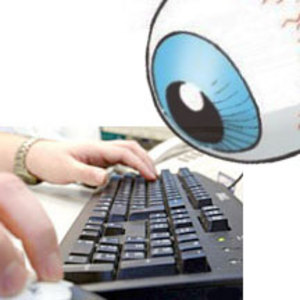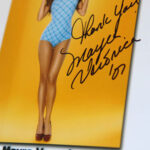Unless you see the celebrity sign an autograph item himself or herself, there is a very good chance it is not real. From a serious collector’s point of view, even a reproduction produced by a device that duplicates the celebrity’s signature precisely is worthless.
So, just what are you getting?
Facsimile Signatures
To accommodate fans, celebrities often send out copies of autographed photos, in effect, autographs-by-proxy. Sometimes it can be hard to tell the difference and you have to look carefully, tilt the signed portion of the photo in the light, look for a signature impression on the back. I remember a celebrity auction where a facsimile photograph of a football player went for more than $40-$50. I don’t know whether people examined it or not before hand, but they paid a lot for a photograph of a signed photograph.
Secretarial Signers
Secretaries routinely sign for their celebrity boss. It isn’t just secretaries. I have a clipping buried somewhere in one of my clipping files about a Hollywood service that answers fan mail for celebrities and sends out “signed” photos. Over the years, many major stars have used secretarial signatures, including Clint Eastwood, Bob Hope, and Frank Sinatra. There was even a book published about President Jimmy Carter’s secretary and her Carter signatures.
Autopen
The autopen reproduces an authentic signature from a template. Politicians began using them at least as far back as President John F. Kennedy who, if I recall correctly, was reported to have had six distinctly different autopen signatures. Other celebrities from Hollywood to NASA began picking them up as well. The way to detect autopen signatures is to compare different examples. They should be almost precisely alike. Not “precisely” because there can be some slight variations in wobble of the stylus, ink consistency, that sort of thing. But if you superimpose one over the other, the match should be obvious.
Rubber Stamp Signatures
Some autographs are generated with a rubber stamp reproducing the celebrity’s signature and using it. It’s too easily detected and is falling into disuse.
Solutions
So what do you do to avoid signatures that are not authentic. One suggestion is to send an item you want signed. Ask for a signed photo and you might go into the “have the secretary do this” stack. An unusual item might get a response, too. I sent Hank Ketchum a reissued paperback of Dennis the Menace cartoons just like the paperback that used to float around our home when I was a kid and he wrote a note in a balloon over Dennis’ head on the facing page, “Gee, Unca Nick, this is sure an old book.” (For what it’s worth, I was in the Army at the time, writing from an APO in Germany and I came to realize that set my request apart from the usual. Ketchum included a drawing inside the cover of Dennis waving an American flag. It was a very nice item.)
You can also encourage a response by indicating familiarity with the celebrity’s work, especially if you can smoothly point up something that might be obscure to other fans. But don’t write a long letter and don’t expect to make the person a pen pal.
No celebrity is required to respond at all, much less return anything you send them, even when you enclose postage and a mailer for the item’s return (as you always should).
Generally, Hollywood celebrities seem to be pretty responsive, because their fan base is perceived as important to their success, sports figures seem somewhat less responsive. Naturally, by picking a collecting specialty that is less obvious, such as pro golfing or military heroes, you stand a better chance of success.
Reference:
- What Makes an Autograph Valuable? www.associatedcontent.com/article/510253/what_makes_an_autograph_valuable.html?cat=2






